In a world where sustainability is at the forefront of our minds, the concept of human-centric lighting may seem like a modern buzzword. However, the implications of this approach go far beyond trendy terminology.
By focusing on the intersection of lighting design and human needs, we uncover a realm of possibilities that not only benefit the environment but also significantly impact the way we interact with our surroundings.
As we delve into the depths of human-centric lighting solutions, a new perspective emerges, shedding light on a path towards a more sustainable future that is both enlightening and promising.
Key Takeaways
- Human-centric lighting enhances well-being and productivity.
- Sustainable lighting practices reduce energy consumption and carbon footprint.
- Technology-driven efficiency maximizes energy savings and user comfort.
- Environmental impact and resource conservation are prioritized through sustainable lighting solutions.
Benefits of Human-Centric Lighting
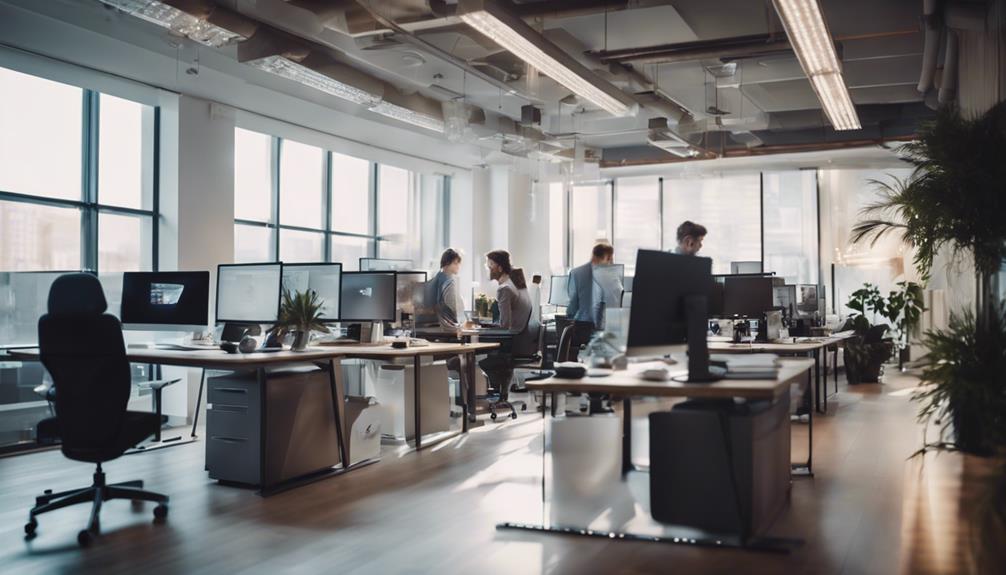
Human-centric lighting offers a myriad of benefits, enhancing productivity and well-being through tailored illumination solutions. By aligning with our natural circadian rhythms, this lighting approach promotes better health by regulating sleep patterns and hormones. Our bodies respond positively to the dynamic lighting adjustments, leading to improved overall well-being and reduced risk of health issues associated with disrupted circadian rhythms.
Furthermore, the impact of human-centric lighting on productivity and performance is significant. Studies have shown that individuals exposed to proper lighting conditions experience increased focus, alertness, and cognitive function. This translates to higher work efficiency, creativity, and overall performance in various tasks. The ability to customize lighting based on specific needs and activities further enhances the practicality of human-centric lighting solutions, allowing for optimal illumination levels tailored to each situation.
In essence, human-centric lighting not only supports our health by regulating circadian rhythms but also elevates productivity and performance through its tailored approach to illumination.
Impact on Energy Consumption
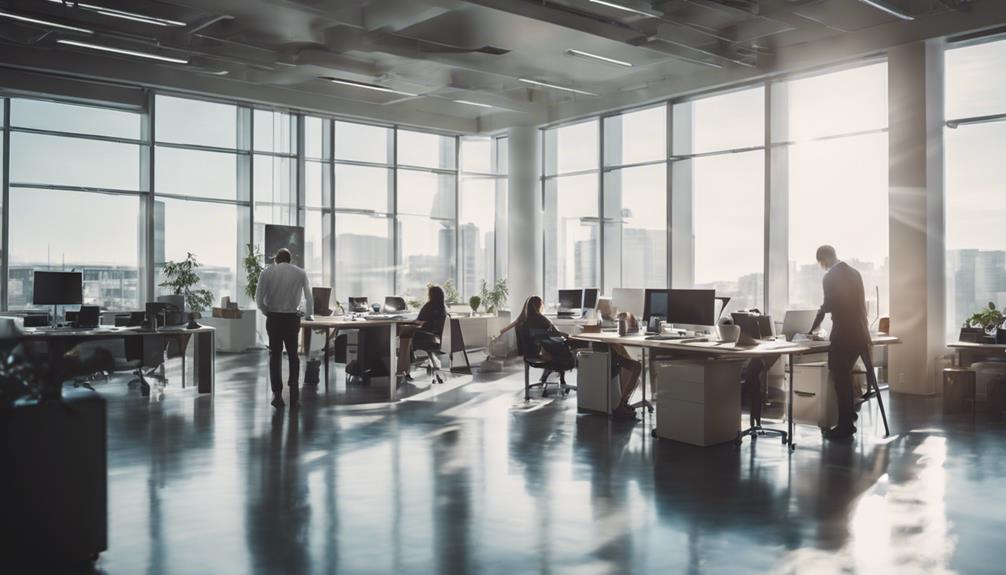
By implementing energy-efficient lighting solutions, we can significantly reduce our carbon footprint and contribute to sustainable practices.
Transitioning to human-centric lighting not only enhances our well-being but also plays a crucial role in conserving energy resources.
Embracing sustainable lighting practices aligns with our commitment to both environmental stewardship and efficiency.
Energy-Efficient Lighting Solutions
How can energy-efficient lighting solutions revolutionize energy consumption in the realm of sustainability?
Energy-efficient lighting solutions have the potential to significantly reduce energy consumption and promote a more sustainable environment. Here are three key ways these solutions impact energy usage:
- LED Technology: The adoption of LED lighting technology leads to substantial energy savings due to its high efficiency and long lifespan.
- Smart Lighting Systems: Implementing lighting control systems allows for precise management of light levels, reducing unnecessary energy usage.
- Daylight Harvesting: Utilizing natural light through sensors and automated controls not only saves energy but also enhances the well-being of occupants.
Reducing Carbon Footprint
To reduce our carbon footprint and positively impact energy consumption, implementing carbon-neutral lighting solutions is paramount. Sustainable architecture and innovation play a crucial role in developing green technology solutions that significantly reduce the environmental impact of lighting systems.
By integrating energy-efficient LEDs, sensors, and smart controls, buildings can optimize lighting levels based on occupancy and natural light availability, minimizing energy waste. Additionally, incorporating renewable energy sources, such as solar panels, to power lighting fixtures further enhances sustainability.
These innovative approaches not only decrease carbon emissions but also contribute to cost savings for building owners in the long run. Embracing such practices aligns with a commitment to environmental stewardship while advancing towards a more sustainable future.
Sustainable Lighting Practices
Implementing sustainable lighting practices is essential for reducing energy consumption and promoting environmental stewardship in modern buildings. When considering eco-friendly design and sustainable architecture, the impact on energy consumption can't be overlooked.
Here are three key sustainable lighting practices that can significantly reduce energy usage:
- LED Lighting: Switching to energy-efficient LED lights can decrease electricity consumption and maintenance costs.
- Natural Light Utilization: Designing spaces that maximize natural light reduces the need for artificial lighting during the day.
- Motion Sensors and Timers: Installing motion sensors and timers helps ensure lights are only used when necessary, saving energy and reducing waste.
Enhancing Wellbeing in Workspaces

When considering enhancing wellbeing in workspaces, we must focus on lighting that caters to productivity, mood, and ambience, along with health benefits.
Our lighting choices can significantly impact how we feel, work, and interact with our environment.
Lighting for Productivity
Enhancing productivity and wellbeing in workspaces through strategic lighting solutions is a crucial aspect of creating a conducive environment for optimal performance. Lighting plays a significant role in influencing our circadian rhythms and cognitive functions, directly impacting our ability to stay focused and productive throughout the day.
When designing lighting for productivity, consider the following:
- Adjustable Intensity: Providing the flexibility to control light intensity based on tasks and preferences can enhance focus and reduce eye strain.
- Natural Light Integration: Incorporating natural light or mimicking its qualities can help regulate circadian rhythms and improve overall alertness.
- Task-specific Lighting: Tailoring lighting solutions to different work areas or tasks can optimize conditions for maximum efficiency and creativity.
Mood and Ambience
To cultivate a harmonious and invigorating atmosphere in workspaces, optimizing mood and ambience through thoughtful lighting choices is paramount. When it comes to lighting design, we must consider the emotional response it evokes in individuals.
Bright, cool-toned lights can promote alertness and focus, ideal for tasks requiring attention to detail. On the other hand, warm, dimmer lighting can create a cozy and relaxing ambiance, fostering creativity and reducing stress.
Health Benefits
In creating workspaces that prioritize wellbeing, we focus on harnessing the health benefits of human-centric lighting solutions. Human-centric lighting, tailored to mimic the natural progression of sunlight, can profoundly impact our health and productivity.
Here are three key ways it enhances wellbeing in workspaces:
- Regulating Circadian Rhythm: By aligning lighting with our natural body clock, human-centric lighting helps regulate sleep patterns, enhance alertness during the day, and improve overall mood and cognitive performance.
- Supporting Mental Health: Proper lighting can positively influence mental health by reducing stress, anxiety, and symptoms of depression, creating a more positive and supportive work environment.
- Boosting Energy Levels: Dynamic lighting solutions can simulate natural daylight, boosting energy levels and combating feelings of fatigue and lethargy typically experienced in artificial lighting environments.
Sustainable Design and Lighting
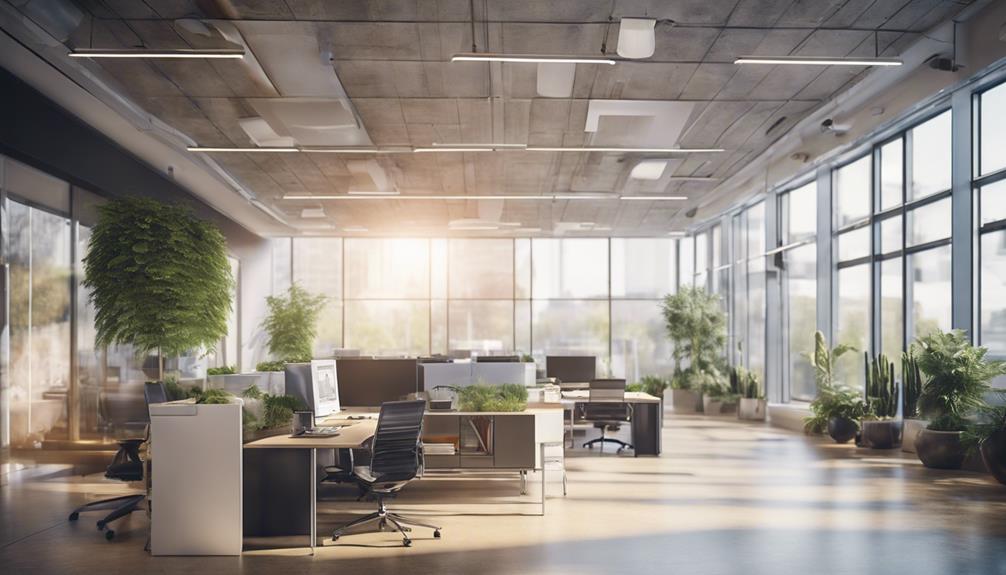
Our approach to sustainable design integrates cutting-edge lighting solutions to enhance energy efficiency and user well-being. By combining lighting innovation with eco-friendly solutions, we strive to create spaces that not only reduce environmental impact but also promote human health and productivity.
Incorporating sustainable design principles into lighting involves utilizing energy-efficient LED fixtures, incorporating natural daylighting strategies, and implementing lighting controls for optimal usage. By selecting materials that are recyclable and choosing fixtures with long lifespans, we aim to minimize waste and resource consumption.
Furthermore, our focus on user well-being extends to the psychological and emotional effects of lighting. Through dynamic lighting systems that mimic natural daylight patterns, we can positively influence circadian rhythms, mood, and overall comfort within a space.
Maximizing Efficiency Through Technology
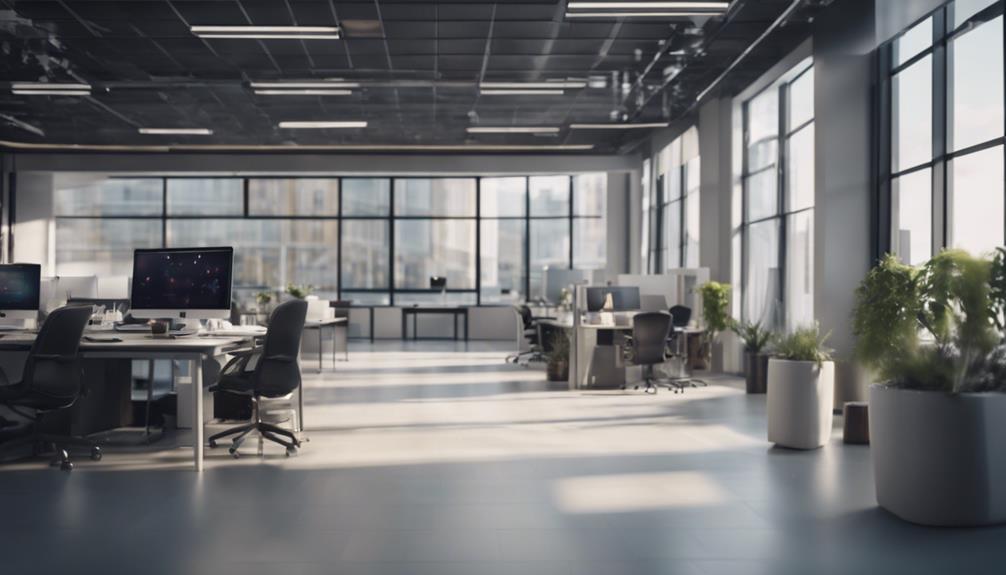
Leveraging advanced sensor technology and smart controls, we optimize lighting systems to maximize energy efficiency and user comfort. Through the integration of smart controls and automation solutions, we can achieve unprecedented levels of efficiency in lighting management. Here are three key ways we maximize efficiency through technology:
- Adaptive Lighting: Implementing smart controls allows lighting systems to adjust based on natural light levels and occupancy, reducing energy consumption while ensuring optimal lighting conditions for users.
- Task Tuning: Automation solutions enable personalized lighting settings tailored to specific tasks or preferences, enhancing user comfort and productivity while minimizing unnecessary energy usage.
- Remote Monitoring: By utilizing smart controls, we can remotely monitor and manage lighting systems, identifying inefficiencies in real-time and making immediate adjustments to improve energy efficiency and overall performance.
With these innovative approaches to maximizing efficiency through technology, we not only reduce environmental impact but also enhance the well-being and productivity of individuals in illuminated spaces.
Case Studies on Sustainable Lighting Practices
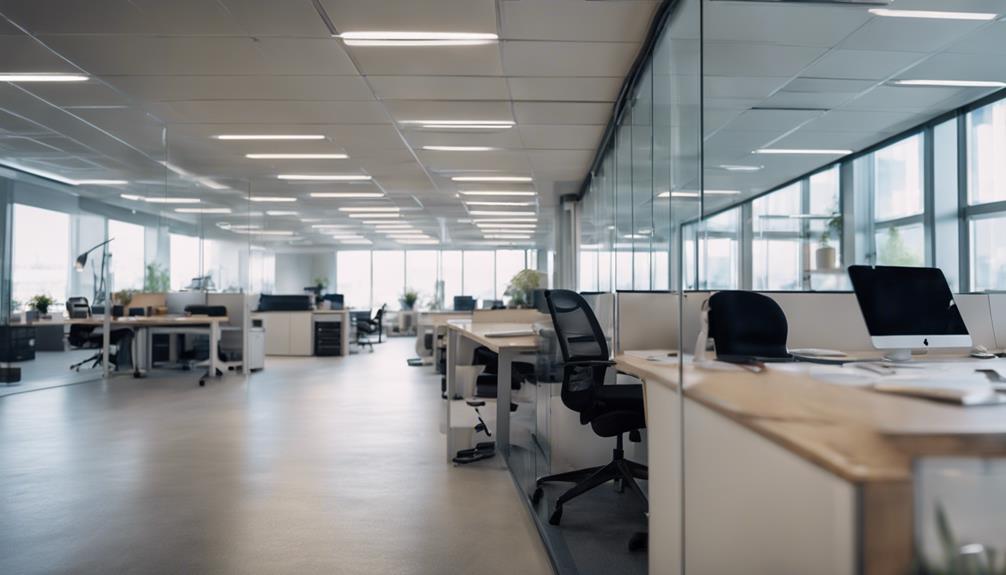
Exploring real-world applications of sustainable lighting strategies reveals the tangible benefits of integrating eco-friendly solutions in diverse environments. When we delve into case studies that showcase the environmental impact of sustainable lighting practices, we witness firsthand the power of sustainable innovation and design trends in reducing energy consumption and promoting a greener future.
To further illustrate this point, let's take a look at some compelling case studies:
| Case Study | Location | Environmental Impact |
|---|---|---|
| Office Renovation | New York City | Reduced energy usage by 30% |
| Street Lighting Upgrade | Tokyo, Japan | Decreased light pollution by 40% |
| Retail Store Redesign | Paris, France | Lowered carbon footprint by 25% |
| Residential Development | Sydney, Australia | Enhanced natural light integration |
| Public Park Illumination | Berlin, Germany | Utilized solar-powered LED fixtures |
These real-world examples demonstrate the positive influence sustainable lighting practices can have on both the environment and the overall quality of different spaces.
Frequently Asked Questions
Can Human-Centric Lighting Solutions Be Customized Based on Individual Preferences and Needs?
Absolutely, human-centric lighting solutions can indeed be tailored to suit individual preferences and needs.
Personalized customization in lighting not only enhances the aesthetic appeal of a space but also contributes significantly to the well-being benefits it offers.
How Do Human-Centric Lighting Solutions Address Issues Related to Circadian Rhythm Disruption and Sleep Disorders?
When it comes to addressing circadian rhythm disruptions and sleep disorders, human-centric lighting solutions shine bright. By harnessing the power of light therapy, these innovative solutions can help regulate our natural cycles, promoting better health and productivity.
The strategic use of light in our daily lives can work wonders in syncing our internal clocks and fostering a sense of balance. It's truly fascinating how light can shape our well-being.
What Are the Long-Term Financial Benefits of Investing in Sustainable Lighting Designs?
Investing in sustainable lighting designs offers substantial long-term financial benefits. Cost savings are achieved through energy efficiency, reducing operational expenses.
Additionally, improved lighting positively impacts employee well-being, leading to increased productivity and overall satisfaction.
How Can Sustainable Lighting Practices Contribute to Reducing Carbon Footprint and Overall Environmental Impact?
Sustainable lighting practices, like energy-efficient designs, play a crucial role in reducing our carbon footprint and overall environmental impact. By prioritizing environmental conservation and health benefits, we can create lighting solutions that not only enhance design aesthetics but also promote a greener future.
Embracing these practices allows us to make conscious choices that positively impact our planet and contribute to a healthier, more sustainable environment for generations to come.
Are There Any Regulations or Standards in Place to Ensure the Implementation of Sustainable Lighting Practices in Commercial Buildings?
Regulations and compliance, a thrilling duo that keeps us on our toes in the world of sustainable lighting. Like a well-choreographed dance, these standards ensure that commercial buildings toe the line when it comes to eco-friendly illumination.
From energy-efficient bulbs to smart lighting controls, the rules are there to guide us towards a greener future. Let's embrace these guidelines as our partners in crime for a brighter, more sustainable tomorrow.
How Does Human-Centric Lighting Contribute to Sustainable Practices?
Human-centric lighting not only boosts well-being but also embodies environmental stewardship. By mirroring natural light patterns, it reduces energy consumption and CO2 emissions, demonstrating clear ways humancentric lighting advances sustainability. Its adaptive technologies allow for efficient resource use, cutting ecological footprints while optimizing human health.
Conclusion
In conclusion, human-centric lighting solutions are the beacon guiding us towards a more sustainable future.
Like a gentle sunrise illuminating a path through the darkness, these innovative technologies not only reduce energy consumption but also enhance wellbeing in our workspaces.
By embracing sustainable design and maximizing efficiency through technology, we can create a brighter, more balanced world for generations to come.
Let's light the way towards a greener tomorrow.








